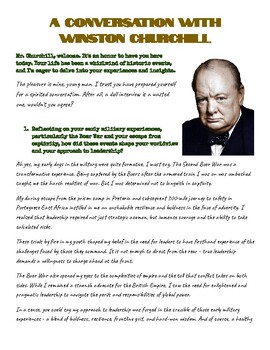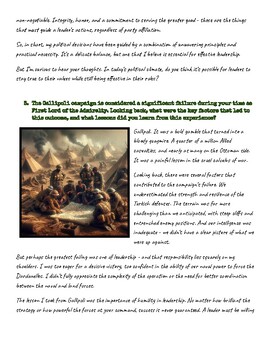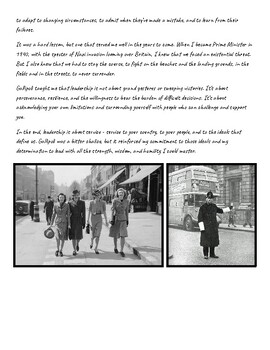A Conversation with Winston Churchill - History / Socials
- PDF
Description
Engage Your Students in a Conversation with History: A Unique AI-Powered Interview with Winston Churchill
Bring history to life with this innovative resource! This simulated interview, powered by artificial intelligence, offers a unique and engaging way for your students to explore the life, legacy, and complexities of one of the 20th century's most iconic figures: Winston Churchill.
What's Included:
12 Poignant Interview Questions: Covering key events and themes from Churchill's life, including his early military experiences, political career, leadership during World War II, and views on the Cold War.
Project & Assignment Ideas: Historical analysis, research, creative & analytical Projects.
Churchill's Thoughtful Responses: Crafted using historical accuracy and cutting-edge AI technology to emulate Churchill's characteristic wit, eloquence, and strong opinions.
Benefits:
- Promotes active learning and historical inquiry
- Develops critical thinking and analytical skills
- Encourages perspective-taking and empathy
- Provides a springboard for research and further exploration
- Introduces students to the potential of AI in education
- Suitable for individual, small group, or whole-class activities
Perfect for history, social studies, government, and language arts classrooms
Go beyond textbooks and lectures! This resource offers a dynamic and interactive way to engage your students with history and delve deeper into the life and times of Winston Churchill. The use of AI adds a modern twist and sparks curiosity about the evolving role of technology in education.
Spark lively classroom discussions and ignite your students' curiosity about the past and the future!
Aligning with Learning Objectives:
While specific standards might vary depending on your state or country, here's how this resource aligns with common learning objectives found in frameworks like Common Core State Standards (CCSS) and Texas Essential Knowledge and Skills (TEKS):
Analyzing Text Structure and Author's Purpose: Students will analyze how the interview format structures information and how Churchill's responses reveal his perspectives and purpose in conveying his experiences. (e.g., CCSS.ELA-LITERACY.RH.6-8.6, TEKS 8.6.B)
Evaluating Arguments and Evidence: Students will evaluate the historical accuracy of Churchill's statements and the evidence he provides to support his views. (e.g., CCSS.ELA-LITERACY.RH.9-10.8, TEKS 8.16.A)
Integrating and Evaluating Multiple Sources: The interview can be used alongside other historical texts and materials to provide a more comprehensive understanding of Churchill and his era. (e.g., CCSS.ELA-LITERACY.RH.11-12.9, TEKS 8.22.C)
Writing:
Writing Arguments: Students can use the interview as a springboard to write argumentative essays, taking a stance on Churchill's actions or the historical events discussed. (e.g., CCSS.ELA-LITERACY.WHST.9-12.1, TEKS 8.21.A)
Research and Inquiry: The interview can inspire students to conduct further research on Churchill, World War II, or other related topics. (e.g., CCSS.ELA-LITERACY.WHST.9-12.7, TEKS 8.19.B)
Speaking and Listening:
Comprehension and Collaboration: Students can engage in discussions about the interview, sharing their interpretations and perspectives while actively listening to their peers. (e.g., CCSS.ELA-LITERACY.SL.9-10.1, TEKS 8.24.A)
Presentation of Knowledge and Ideas: Students can present their research findings or arguments based on the interview, using evidence to support their claims. (e.g., CCSS.ELA-LITERACY.SL.11-12.4, TEKS 8.25.B)





